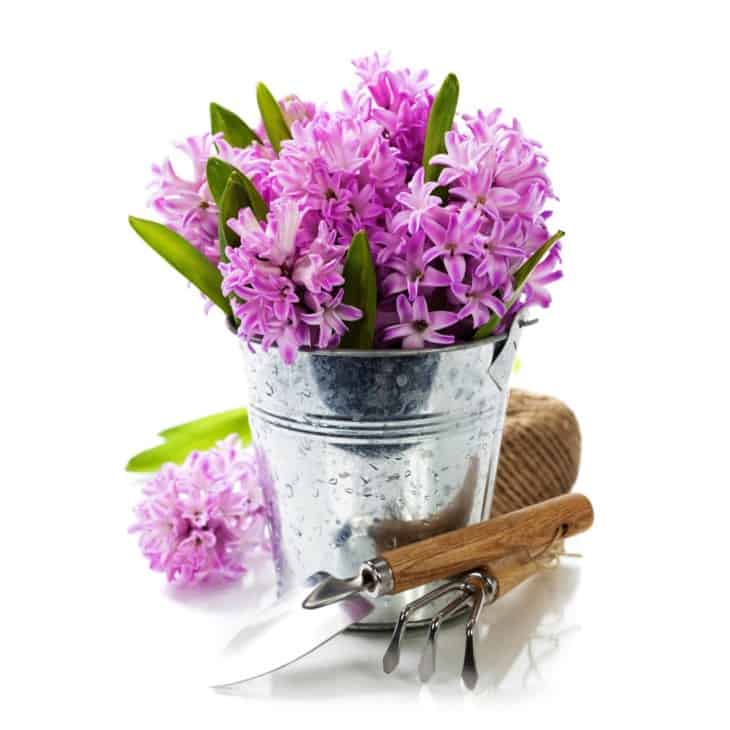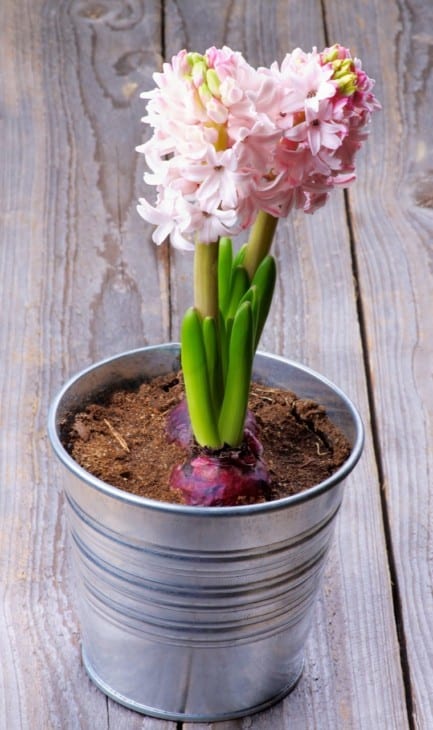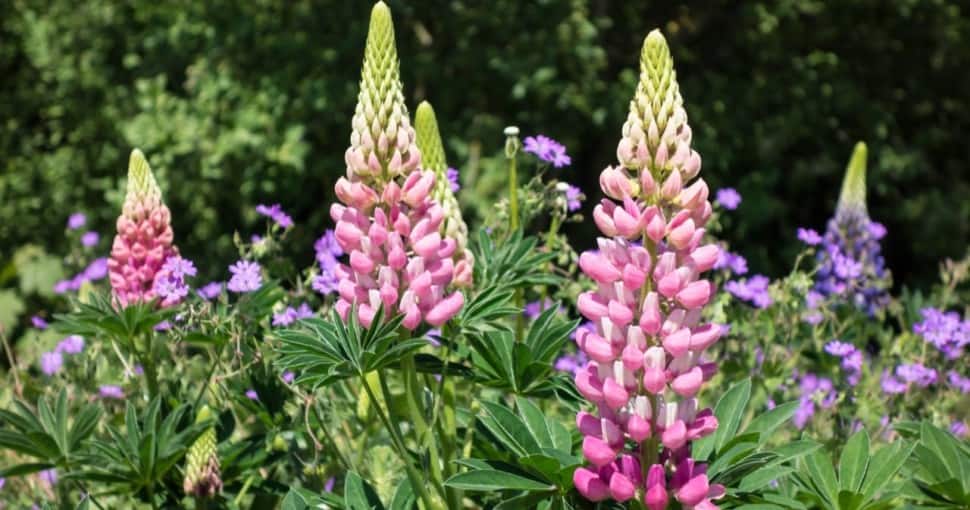Hyacinths are such bright pretty plants to add to a garden flower bed. They are available in many different colors, allowing the gardener to create color swirls, matching them to similar colored plants, or enjoying an explosion of different mixed colors. Gardeners have favored them for centuries. Not only are hyacinths colorful, but they have a sweet, enticing scent. Could something so beautiful be deadly?
Contents
- Which Parts Of A Hyacinth Are Toxic?
- What Is Oxalic Acid Poisoning?
- Are Hyacinths Toxic To People?
- What Are The Symptoms Of Hyacinth Poisoning In People?
- Are Hyacinths Toxic To Dogs?
- Are Hyacinths Toxic To Cats?
- Are Hyacinths Poisonous To Birds?
- Are Grape Hyacinths Toxic?
- Is Water Hyacinth Toxic?
- How Does Hyacinth Poisoning Happen In People?
- Conclusion
Hyacinths are perennial plants growing from bulbs. Hyacinths contain oxalic acid, which is found in the flowers, leaves, and stems in small quantities. The highest levels are found in the bulbs. Oxalic acid is highly poisonous to people, dogs, and cats, causing burns and other severe symptoms.
Hyacinths may be grown in flower beds in the garden or kept in pots indoors. Their clusters of star-shaped flowers brighten up the home and garden.
Which Parts Of A Hyacinth Are Toxic?
The stem, leaves, and flowers of hyacinths have low levels of toxins. The toxic oxalates or oxalic acid are concentrated in the bulb, making this the most likely part of the plant to cause poisoning.
What Is Oxalic Acid Poisoning?
Oxalic acid is a highly caustic substance causing severe chemical burns when it comes into contact with living tissue. Oxalates or oxalic acid are found as crystals with sharp corrosive points that are harmful. Oxalic acid may also be found in other plants, such as the leaves of the rhubarb plant.
Plants usually contain these kinds of chemicals to protect themselves from destruction by foraging animals and insects. Protecting the plant and especially the bulb ensures that hyacinths are not eradicated as a species.

Are Hyacinths Toxic To People?
Hyacinths are toxic to people, and it is strongly recommended that even when you are handling hyacinth bulbs, gloves should be worn. Failure to do this results in red, painful, irritated skin, which may blister.
Ingesting hyacinth bulbs causes severe and life-threatening symptoms. The caustic nature of oxalic acid found in hyacinths burns the mouth, the esophagus, and the lining of the stomach and intestines.
Oxalic acid burns through several layers of the mucous membrane resulting in ulcers that inhibit eating, food digestion and can lead to life-threatening internal bleeding.
What Are The Symptoms Of Hyacinth Poisoning In People?
The symptoms of hyacinth poisoning result from touching and ingesting the plant, particularly the bulb. The symptoms include:
- Abdominal pain
- Diarrhea
- Blisters, ulcers, and redness in the oral membranes
- Burning pain in the mouth
- Drooling
- Nausea
- Vomiting
- Throat swelling – the esophagus may swell to such an extent that it presses on the trachea.
- Restricted airways cause breathing issues. This is usually a result of breathing in dust from the hyacinth bulb or from swelling. It can trigger an asthma attack in those prone to respiratory conditions.
- Shock
- Tremors
- Seizures
- Collapse
- Contact with the eyes will result in extreme pain and possible loss of vision which may be temporary or permanent.
If someone eats a hyacinth bulb or reacts to touching the hyacinth bulb, they should be taken for medical treatment immediately. The patient that needs to be hospitalized will be admitted to the burns unit. Other parts of the plant may cause milder reactions, but medical treatment may still be necessary.

Are Hyacinths Toxic To Dogs?
Dogs are diggers and chewers, and unfortunately, they are apt to dig up plants and chew on them, bulbs and all. They are also often mischievous and may steal and chew hyacinths waiting to be planted.
The severity of the hyacinth poisoning symptoms will be related to how much of the plant the dog eats and what part of the plant is eaten. Fortunately, hyacinth plants cause immediate burning in the mouth, which usually deters most dogs from eating large quantities.
The symptoms seen in a dog poisoned by hyacinths would be similar to those seen in people. There would also be
- Drooling
- Cardiac arrhythmias
- Convulsions
- Increased heart rate
- Low blood pressure
- Coughing
- Wheezing
- Distress
Whisk your dog off to the vet if you find your dog chewing a hyacinth or notice any symptoms that indicate he may have poisoning from a hyacinth.
Are Hyacinths Toxic To Cats?
Hyacinths are incredibly toxic to cats. They would show symptoms of oxalic acid poisoning that would include:
- Depression and lethargy
- Mouth pain – the cat may try to wipe its mouth with its paws and will not want to eat.
- Bloody diarrhea
- Salivation
- Nausea
- Vomiting
- Respiratory distress
- Weakness
- Tremors
- Shock
- Collapse
It is critical to get your cat attended to by a veterinarian as soon as possible. The prognosis for a cat poisoned by hyacinths depends on rapid veterinary intervention.
Are Hyacinths Poisonous To Birds?
Hyacinths cause toxicity in birds. They burn the bird’s mouth and gastrointestinal system. Fortunately, most birds would be deterred by the first taste of hyacinth. It would burn the mouth, and the bird is unlikely to continue eating the plant.
Are Grape Hyacinths Toxic?
Grape hyacinths grow from bulbs, just like true hyacinths. Grape hyacinths are not toxic in any way, and the entire plant may be regarded as a safe plant to grow when children and pets are present in the home.
They are a different species of plant to true hyacinth. They have clusters of purple flowers that look similar to a bunch of grapes.
Is Water Hyacinth Toxic?
Water hyacinth is an invasive weed that has taken over many waterways worldwide. It contains oxalates in all parts of the plant. It causes symptoms of poisoning in people or animals that ingest it.
How Does Hyacinth Poisoning Happen In People?
Hyacinth poisoning due to ingestion usually occurs in small children that do not know any better. Accidental ingestion in adults has been known to occur. It is generally because the adult mistakes the bulb for a root vegetable such as an onion.
Conclusion
Hyacinths are extremely toxic plants, and care should be exercised when handling the plant, especially if the bulb is exposed. Gardeners that are planting hyacinths should wear protective gloves to prevent skin irritation.







